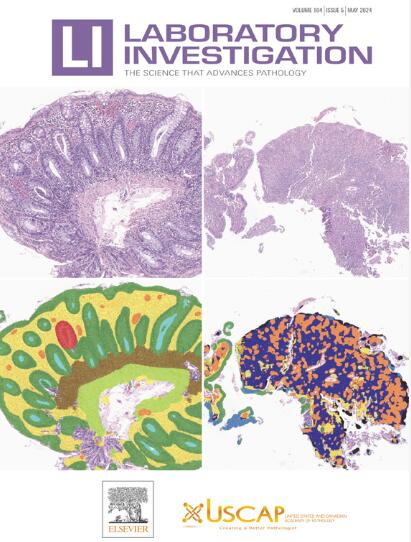Spatiotemporal Cellular Dynamics of Germinal Center Reaction in Coronavirus Disease 2019 Lung-Draining Lymph Node Based on Imaging-Based Spatial Transcriptomics
IF 5.1
2区 医学
Q1 MEDICINE, RESEARCH & EXPERIMENTAL
引用次数: 0
Abstract
Although lymph node structures may be compromised in severe SARS-CoV-2 infection, the extent and parameters of recovery in convalescing patients remain unclear. Therefore, this study aimed to elucidate the nuances of lymphoid structural recovery and their implications for immunologic memory in nonhuman primates infected with SARS-CoV-2. To do so, we utilized imaging-based spatial transcriptomics to delineate immune cell composition and tissue architecture formation in the lung-draining lymph nodes during primary infection, convalescence, and reinfection from COVID-19. We noted the establishment of a germinal center with memory B cell differentiation within lymphoid follicles during convalescence accompanied by contrasting transcriptome patterns indicative of the acquisition of follicular helper T cells versus the loss of regulatory T cells. Additionally, repopulation of germinal center-like B cells was observed in the medullary niche with accumulating plasma cells along with enhanced transcriptional expression of B cell-activating factor receptor over the course of reinfection. The spatial transcriptome atlas produced herein enhances our understanding of germinal center formation with immune cell dynamics during COVID-19 convalescence and lymphoid structural recovery with transcriptome dynamics following reinfection. These findings have the potential to inform the optimization of vaccine strategies and the development of precise therapeutic interventions in the spatial context.
基于成像的空间转录组学研究COVID-19肺引流淋巴结生殖中心反应的时空细胞动态。
虽然淋巴结结构在严重的 SARS-CoV-2 感染中可能受到损害,但康复期患者的恢复程度和参数仍不清楚。因此,本研究旨在阐明感染 SARS-CoV-2 的非人灵长类动物淋巴结构恢复的细微差别及其对免疫记忆的影响。为此,我们利用基于成像的空间转录组学来描述 COVID-19 在原发感染、康复和再感染期间肺部引流淋巴结的免疫细胞组成和组织结构形成。我们注意到,在康复期,淋巴滤泡内建立了具有记忆性 B 细胞分化的生殖中心,同时出现了表明滤泡辅助性 T 细胞获得与调节性 T 细胞丧失的对比转录组模式。此外,在髓质龛中还观察到了生殖中心样 B 细胞的重新增殖,浆细胞不断积累,B 细胞活化因子受体的转录表达在再感染过程中也得到了增强。本文绘制的空间转录组图谱增强了我们对COVID-19康复期生殖中心形成与免疫细胞动态以及再感染后淋巴结构恢复与转录组动态的了解。这些发现有可能为优化疫苗策略和开发精确的空间治疗干预措施提供信息。
本文章由计算机程序翻译,如有差异,请以英文原文为准。
求助全文
约1分钟内获得全文
求助全文
来源期刊

Laboratory Investigation
医学-病理学
CiteScore
8.30
自引率
0.00%
发文量
125
审稿时长
2 months
期刊介绍:
Laboratory Investigation is an international journal owned by the United States and Canadian Academy of Pathology. Laboratory Investigation offers prompt publication of high-quality original research in all biomedical disciplines relating to the understanding of human disease and the application of new methods to the diagnosis of disease. Both human and experimental studies are welcome.
 求助内容:
求助内容: 应助结果提醒方式:
应助结果提醒方式:


